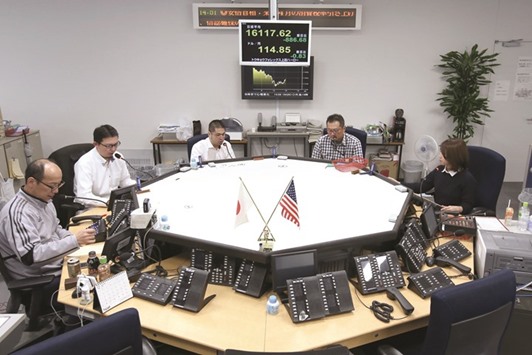The most oversold Group-of-10 currency since the US election is making a comeback.
A reassessment on the likelihood of pro-growth policies in the US after the failure of the healthcare bill last week, and a series of domestic and technical factors have combined to reignite buying interest in the yen, and analysts see more upside.
Rising Japanese real-interest rates, the yen’s haven status from global political uncertainty and technical signals monitored by foreign exchange traders have helped the currency rebound 7% from December lows against the dollar. Momentum is building and a further 2% rise to 108 yen per dollar is possible by June, according to market participants.
“A Japan specific factor is gradually having an impact to boost the yen, as waning inflation expectations are pushing up real interest rates,” said Minori Uchida, head of global market research at Bank of Tokyo-Mitsubishi UFJ in Tokyo. “The yen may climb toward 108 levels by June. With Trump expectations possibly starting to fade, we are considering revising our current year-end forecast of 107.” Although core consumer prices rose 0.1% in January, the first increase in 13 months, it was mostly driven by a rebound in oil prices. At its March meeting, the Bank of Japan conceded that right now, inflation expectations are still weakening.
The yen rose as much as 1.1% yesterday to the highest since November 18, after last week’s failed US healthcare deal.
It remains about 5% lower against the dollar from when Trump won the US election on November 8, this in itself may also spur investors to buy back the Japanese currency, according to Uchida. Dollar-yen one-month risk reversals, an indicator of market sentiment and option positioning, suggest that bearish option bets on the pair reached the highest in four months on Thursday.
The yen’s decline after the election has been closely tied to expectations for reflationary policies pledged by Trump, which boosted the dollar.
His handling of the healthcare bill has raised doubts about his ability to push through policies and fuelled concerns his fiscal stimulus may be scaled down.
“It’s generally dollar selling that we are seeing, not just against the yen,” said Satoshi Okagawa, senior global market analyst at Sumitomo Mitsui Banking Corp in Singapore. Trump’s reduced political clout makes his policies less impactful than initially hoped for, he said. “That will lead to a weaker dollar and send the yen past 110 to around 108.”
The dollar falling below the ¥111.35 level, seen as a technical support, also sends a near-term sell signal, according to Tatsuhiro Iwashige, chief foreign-exchange strategist of the investment solutions group at Tokyo-based GCI Asset. The currency pair stabilising below that level would be a signal of longer-term selling momentum towards 107.50.
Still, the yen is unlikely to reach the 100 level, given the difference in interest rate outlooks , according to SMBC’s Okagawa. The Fed voted to lift rates for the second time in three months on March 15 and signalled that more hikes are coming. The Bank of Japan kept its unprecedented monetary easing programme unchanged a day later.
Okagawa points to the swap market as a guide. Two-year US-Japan swap rates, which traded around 1% when the yen was about 100 to the dollar, have risen to around 1.5%. This suggests a level for the dollar-yen closer to 110 than 100, to be “more or less” in line with the rate differentials, he said.
Yoshisuke Kiguchi, who manages a retirement-savings pool as chief investment officer at the Okayama Metal & Machinery Pension Fund in Okayama City agreed. He said a level of 100 yen would not be sustainable unless Japan slips into deflation again.
Kengo Suzuki, chief currency strategist at Mizuho Securities Co in Tokyo, sees 108 as possible, but for a further slide to take place, “expectations on Trump have to be completely wiped out.”
Beyond interest rate differentials, the political and monetary environment in Europe is also bolstering the yen.
Japan is seen as a haven, in particular against French political risk, according to Okagawa. And Bank of Tokyo-Mitsubishi’s Uchida suggested any weakening of the European Central Bank’s accommodative monetary stance, expectations of which have led to a rise in the euro this year, would also boost the yen.
“The firming euro/dollar means the dollar is entering the phase where it will struggle to gain broadly, adding another factor boosting the outlook for the yen,” he said.
Analysts have begun to pare back their forecasts for yen weakness for the first half of 2017. They now see a level of 115 yen to the dollar by the end of June, compared to a forecast of 118 at the end of January according to a survey by Bloomberg.

Currency traders work in the dealing room of a foreign exchange brokerage in Tokyo. Rising Japanese real-interest rates, the yen’s haven status from global political uncertainty and technical signals monitored by foreign exchange traders have helped the currency rebound 7% from December lows against the dollar.


